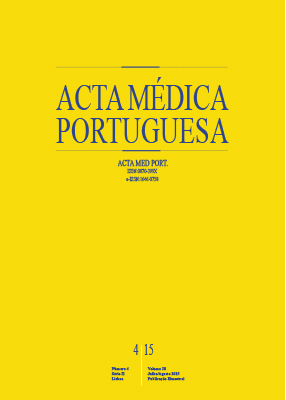The Role of Aspirin in Preeclampsia Prevention: State of the Art
DOI:
https://doi.org/10.20344/amp.6005Keywords:
Aspirin, Pre-Eclampsia/prevention & control.Abstract
Introduction: The role of acetyl salicylic acid (ASA or aspirin) in preeclampsia prevention and in other complications has been subject to studies and controversies for the last 30 years. The first research results concerning the role of placenta in preeclampsia have been published by the end of seventies and they showed an increase in the platelet activity and a prostaglandin synthesis disturbance, as a consequence of a deficient placentation. In the last twenty years of the XX century important studies were published on the aspirinprophylactic role in preeclampsia risk reduction.
Material and Methods: To analyze published studies about Aspirin use for preeclampsia prevention and about the more adequate dosage to be administered, Medline was used for searching the most relevant prospective research papers on this subject in order to evaluate current evidence about the use of aspirin in this context. Relevant citations were extracted from Embase, PubMed and the Cochrane Central Register of Controlled Trials. We divided the studies in two groups; one with aspirine administration before 16 weeks and the other having a larger use, between the first and the third trimester.
Results and Discussion: The first group of studies, with a lesser number of cases but an earlier time of administration until 16 weeks, concluded that a positive role of aspirine was possible in reducing severity of preeclampsia; the second group with a larger number of cases but less restricted conditions and timing of administration, had controversial results, with reduced positive actions of the drug. Meta-analysis of these published studies concluded that favorable results were associated to stricter criteria and ideal timing for starting
the drug.
Conclusion: As we do not have other pharmacologic alternatives, low dosage of Aspirin between 80-150 mg a day in the first trimester and until 16 weeks, at evening time, is a possible choice in cases of risk, and is still contributing for an early preeclampsia risk reduction.
Downloads
Downloads
Published
How to Cite
Issue
Section
License
All the articles published in the AMP are open access and comply with the requirements of funding agencies or academic institutions. The AMP is governed by the terms of the Creative Commons ‘Attribution – Non-Commercial Use - (CC-BY-NC)’ license, regarding the use by third parties.
It is the author’s responsibility to obtain approval for the reproduction of figures, tables, etc. from other publications.
Upon acceptance of an article for publication, the authors will be asked to complete the ICMJE “Copyright Liability and Copyright Sharing Statement “(http://www.actamedicaportuguesa.com/info/AMP-NormasPublicacao.pdf) and the “Declaration of Potential Conflicts of Interest” (http:// www.icmje.org/conflicts-of-interest). An e-mail will be sent to the corresponding author to acknowledge receipt of the manuscript.
After publication, the authors are authorised to make their articles available in repositories of their institutions of origin, as long as they always mention where they were published and according to the Creative Commons license.









